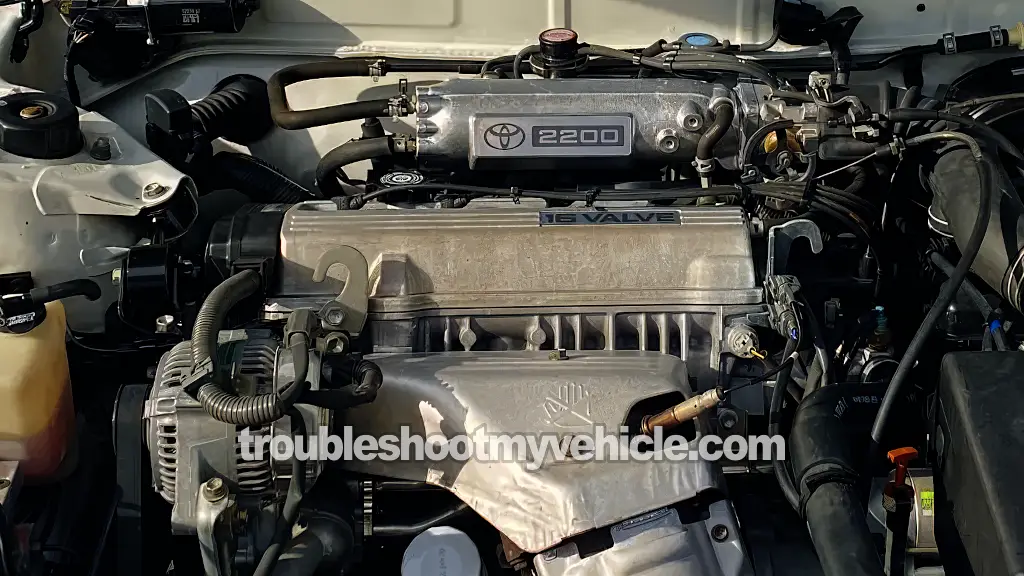
The 1992-2001 Toyota Camry's 2.2L engine uses a timing belt. If it snaps, the engine's gonna crank but won't start.
In this tutorial, I'll show you the most common tests to check if a broken timing belt is the reason your engine won't start.
NOTE: The 2.2L 5S-FE engine in your Camry is a non-interference engine, so a broken timing belt won't cause internal engine damage (like bent valves or broken pistons).
Contents of this tutorial:
- What Does The Timing Belt Do?
- Symptoms Of A Broken Timing Belt.
- TEST 1: Checking Distributor Rotor Rotation (1992-1996 Models).
- TEST 2: Observing Camshaft Rotation.
- TEST 3: Inspecting The Timing Belt Via Upper Timing Cover.
- TEST 4: Check For Zero Engine Compression.
- TEST 5: Inspect For Timing Belt Service History.
- More 2.2L Toyota Camry Tutorials.
APPLIES TO: This tutorial applies to the following vehicles:
- 2.2L Toyota Camry: 1992, 1993, 1994, 1995, 1996, 1997, 1998, 1999, 2000, 2001.
What Does The Timing Belt Do?
The timing belt keeps the rotation of the crankshaft and camshaft(s) synchronized. If they don't stay in sync, the engine won't run properly —or at all.
- Crankshaft: Turns the pistons' up-and-down motion into rotation.
- Camshaft(s): Opens and closes the intake and exhaust valves, letting the air/fuel mix in and pushing exhaust out.
The belt makes sure the valves move (open/close) at the right time in relation to the pistons. This timing is key for the engine's four-stroke cycle: intake, compression, combustion, and exhaust.
Symptoms Of A Broken Timing Belt
The most common symptoms of a broken timing belt on the 1992–2001 Toyota Camry 2.2L (5S-FE engine) are:
- Engine cranks normally but doesn't start:
- When you turn the key, the engine's gonna crank, but it won't start.
- This happens because the timing belt connects and synchronizes the crankshaft and camshafts. If it snaps, the camshafts stop turning, shutting down valve operation. In distributor equipped models, spark isn't produced.
- No valve movement means air/fuel can't get in, and exhaust can't get out.
- Faster cranking speed:
- The engine cranks faster than usual due to zero compression in all cylinders.
- Without the timing belt, the valves remain stationary, so no air/fuel mixture is compressed during cranking.
- Zero compression across all cylinders:
- A compression test will show 0 PSI across the board. Since the valves aren't opening or closing, there's no compression.
- This almost always means a broken timing belt or a major timing issue.
- No intake/exhaust valve movement:
- If you pull off the upper timing cover or the valve cover and crank the engine, the camshafts aren't gonna be turning.
- Loss of spark (1992-1996 Models)
- In distributor-equipped models (1992-1996), a broken belt stops the distributor rotor from spinning, resulting in no spark to the plugs.
- Later models (1996–2001) use a distributorless (DIS) ignition system, but the fuel injection computer may disable spark if the camshaft position sensor detects no rotation.
NOTE: The 2.2L (5S-FE) in your 1992–2001 Toyota Camry is a non-interference engine, meaning a broken timing belt won't cause internal damage.
TEST 1: Checking Distributor Rotor Rotation (1992-1996 Models)
The 1992-1996 2.2L Camry comes equipped with a distributor-based ignition system. When the timing belt breaks, the camshafts won't turn, which means the distributor rotor won't spin when you crank the engine.
NOTE: The following test procedure only works for the 1992-1996 models. Starting in 1997, Toyota ditched the distributor for a DIS ignition system on the 5F-SE engine.
- Procedure:
- Disconnect the distributor from its electrical connectors.
- Remove the distributor cap.
- Crank the engine.
- Observe the rotor while cranking the engine.
- If the rotor does not move, the timing belt is likely broken.
TEST 2: Observing Camshaft Rotation
The 2.2L engine in your Camry has two camshafts and both are driven by the timing belt. If the belt breaks, the camshafts aren't gonna turn when the engine is cranking.
If we remove the cylinder head valve cover we can check the rotation or lack of rotation of these two camshafts.
NOTE: This method requires some labor, but it avoids removing the top timing cover (which I find a bit more complicated than removing the valve cover).
- Procedure:
- Remove the valve cover.
- Crank the engine and observe the camshafts.
- If they do not rotate, the timing belt is broken.
TEST 3: Inspecting The Timing Belt Via Upper Timing Cover
On all 1992–2001 models, you can check the physical integrity/condition of the timing belt by pulling off the upper timing cover.
The best part? This method gives you a clear answer and works on every model year.
NOTE: A repair manual might help with step-by-step instructions for removing the cover.
- Procedure:
- Remove the upper timing cover.
- Check for visible damage or fraying of the belt. A broken belt will be obvious.
TEST 4: Check For Zero Engine Compression
When the timing belt breaks, valve timing gets thrown off, and all cylinders lose compression. That makes the engine crank faster than usual (but still won't start).
A compression tester is a must have tool to check all six cylinders.
NOTE: The tutorial below breaks down the compression test step by step and explains how to read your results: How To Test Engine Compression (1990-2001 2.2L Toyota Camry, Celica).
- Procedure:
- Remove all six spark plugs.
- Check the compression of each cylinder.
- If all cylinders show 0 PSI, the timing belt is likely broken.
TEST 5: Inspect For Timing Belt Service History
The 5S-FE engine's timing belt requires replacement every 60,000–90,000 miles (non-interference design). If the belt is overdue, a breakage is more likely.
More 2.2L Toyota Camry Tutorials
You can find a complete list of 2.2L Toyota Camry tutorials and wiring diagrams in this index:
Here's a sample of the tutorials you'll find there:
- How To Test Engine Compression (1990-2001 2.2L Toyota Camry, Celica).
- How To Test For A Blown Head Gasket (1990-2001 2.2L Toyota Camry, Celica).
- How To Test The Fuel Pump (1996-2001 2.2L Toyota Camry).
- How To Test The TPS With A Multimeter (1997-2001 2.2L Toyota Camry).

If this info saved the day, buy me a beer!

